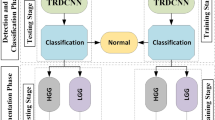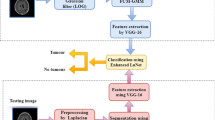Abstract
A supervised CNN Deep net classifier is proposed for the detection, classification and diagnosis of meningioma brain tumor using deep learning approach. This proposed method includes preprocessing, classification, and segmentation of the primary occurring brain tumor in adults. The proposed CNN Deep Net classifier extracts the features internally from the enhanced image and classifies them into normal and abnormal tumor images. The segmentation of tumor region is performed by global thresholding along with an area morphological function. This proposed method of fully automated classification and segmentation of brain tumor preserves the spatial invariance and inheritance. Furthermore, based on its feature attributes the proposed CNN Deep net classifier, classifies the detected tumor image either as (low grade) benign or (high grade) malignant. This proposed CNN Deep net classification approach with grading system is evaluated both quantitatively and qualitatively. The quantitative measures such as sensitivity, specificity, accuracy, Dice similarity coefficient, precision, F-score of the proposed classifier states a better segmentation accuracy and classification rate of 99.4% and 99.5% with respect to ground truth images.















Similar content being viewed by others
Data Availability
The brain images used in this article are available at https://www.smir.ch/BRATS. This dataset is open access and license free.
References
Alanazi, S. A., Kamruzzaman, M. M., Sarker, M. N. I., Alruwaili, M., Alhwaiti, Y., & Siddiqi, N. A. M. H. (2021). Boosting Breast Cancer Detection Using Convolutional Neural Network. Journal of Healthcare Engineering-Automatic Diagnosis of Cancer Using Machine Learning. https://doi.org/10.1155/2021/5528622
Alqazzaz, S., Sun, X., Yang, X., et al. (2019). Automated brain tumor segmentation on multi-modal MR image using SegNet. Comp. Visual Media, 5, 209–219.
Amin, J., Sharif, M., Raza, M., Saba, T., & Anjum, M. A. (2019). Brain tumor detection using statistical and machine learning method. Computer Methods and Programs in Biomedicine-Elsevier, 177, 69–79.
Anaraki, A. K., & MoosaAyati, F. K. (2019). Magnetic resonance imaging-based brain tumor grades classification and grading via convolutional neural networks and genetic algorithms. Biocybernetics and Biomedical Engineering, 39, 63–74.
Badza, M. M., & Barjaktarovic, M. C. (2020). Classification of brain tumors from MRI images using a convolutional neural network. Applied Sciences, 1999, 1–13.
Bakhshi, A., Noman, N., Chen, Z., Zamani, M., Chalup, S. (2019). Fast automatic optimisation of CNN architectures for image classification using genetic algorithm. IEEE Congress on Evolutionary Computation (CEC), 1283–1290. https://doi.org/10.1109/CEC.2019.8790197
Bandhyopadhyay, S. K., & Paul, T. U. (2013). Automatic segmentation of brain tumor from multiple images of brain MRI. International Journal of Application or Innovation in Engineering & Management (IJAIEM), 2, 240–248.
Bansal, S., Kaur, S., & Kaur, N. (2019). Enhancement in Brain Image Segmentation using Swarm Ant Lion Algorithm. International Journal of Innovative Technology and Exploring Engineering (IJITEE), 8, 10.
Bousselham, A., Bouattane, O., Youssfi, M., & Raihani, A. (2019). Towards Reinforced Brain Tumor Segmentation on MRI Images Based on Temperature Changes on Pathologic Area. International Journal of Biomedical Imaging, 2019(1758948), 1–18.
BRATS database, (2015) Available at: <https://www.smir.ch/BRATS/Start2015>.
Chen, X., Zeng, M., & Tong, Y. (2020). Automatic prediction of MGMT status in glioblastoma via deep learning-based MR image analysis. Biomed Research International-Representation Learning in Radiology. https://doi.org/10.1155/2020/9258649
Dandıl, E., & Karaca, S. (2021). Detection of pseudo brain tumors via stacked LSTM neural networks using MR spectroscopy signals. Bio Cybernetics and Biomedical Engineering, 41(1), 173–195.
Dongyao Jia, A., Zhengyi Li, B., & Chuanwang Zhang, C. (2020). Detection of cervical cancer cells based on strong feature CNN-SVM network. Neuro Computing, 411(21), 112–127.
El-Melegy, M.T., Mokhtar, H.M. (2014)Tumor segmentation in brain MRI using a fuzzy approach with class center priors. EURASIP Journal on Image and Video Processing 2014 ,https://doi.org/10.1186/1687-5281-2014-21
Fernandes, S. L., Tanik, U. J., Rajinikanth, V., & Karthik, K. A. (2020). A reliable framework for accurate brain image examination and treatment planning based on early diagnosis support for clinicians. Neural Computing and Applications, 32(20), 15897–15908.
Funmilola, A. Oke, T Adedeji, M. Alade, E.A. Adewusi(2012)Fuzzy K-C-means clustering algorithm for medical image segmentation. J Informat. Eng Appl 2, 21–32. https://pdfs.semanticscholar.org/da58/e39c29c44560426c2fb00b0f8dbeec5c0dd6.pdf.
Ghoneim, Ahmed, Muhammad, Ghulam, & Hossain, Shamim. (2020). Cervical cancer classification using convolutional neural networks and extreme learning machines. Future Generation Computer Systems, 102, 643–649.
Gunasekara, S., Kaldera, K., & Dissanayake, M. B. (2021). A Systematic Approach for MRI Brain Tumor Localization and Segmentation Using Deep Learning and Active Contouring. Journal of Healthcare Engineering-Deep Learning in Bioinformatics and Biomedical Images. https://doi.org/10.1155/2021/6695108
Guo, L., Zhao, L., Wu, Y., Li, Y., Xu, G., & Yan, Q. (2011). Tumor detection in MR images using one-class immune feature weighted SVMs. IEEE Transactions on Magnetics, 47(10), 3849–3852.
Akila Gurunathan, Batri Krishnan(2018) Survey on Different Preprocessing Methods of Enhancement and Segmentation in Medical Images Analysis. Jour of Adv Research in Dynamical & Control Systems,10, 14-Special Issue
Gurunathan, A., & Krishnan, B. (2020). Detection and diagnosis of brain tumors using deep learning convolutional neural networks. International Journal of Medical Imaging Systems, 31(3), 1174–1184.
Havaei, M., Davy, A., David, W. F., Biard, A., Courville, A., & Bengio, Y. (2017). Brain tumor segmentation with Deep Neural Networks. Medical Image Analysis, 35, 18–31.
Iqbal, S., Ghani, M. U., Khan, T. S., Mehmood, Z., Javaid, N., Rehman, A., & Abbasi, R. (2019). Deep learning model integrating features and novel classifiers fusion for brain tumor segmentation. Microscopic research and techniques (pp. 1302–1315). Wiley.
Islam, A., Reza, S. M. S., & Iftekharuddin, K. M. (2013). Multifractal texture estimation for detection and segmentation of brain tumors. IEEE Trans. Biomed. Eng., 60(11), 3204–3215.
Johnpeter, J. H., & Ponnuchamy, T. (2019). Computer aided automated detection and classification of brain tumors using CANFIS classification method. International journal of imaging systems and technology-Wiley, 1–8. https://doi.org/10.1002/ima.22318
Josephine, S. (2018). Brain Tumor MRI Image Detection and Segmentation Using Genetic Algorithm. International Journal of Computer Sciences and Engineering, 6, 2.
Kalaiselvi, T., & Padmapriya, S. (2021). Brain tumor diagnostic system-a deep learning application. Machine Vision Inspection Systems, 2, 69–90.
Khawaldeh, S., Pervaiz, U., Rafiq, A., Alkhawaldeh. R. S. (2017). Noninvasive grading of glioma tumor using magnetic resonance imaging with convolutional neural networks. Applied Sciences, 8.
Kong, Y., Deng, Y., & Dai, Q. (2015). Discriminative clustering and feature selection for brain MRI segmentation. IEEE Signal Processing Letters, 22(5), 573–577.
Konstantinos, K. K., Ledig, C., Virginia, F. J., Joanna, P. S., Andrew, D. K., & David, K. M. (2017). Efficient multi scale 3D CNN with fully connected CRF for accurate brain lesion segmentation. Medical Image Analysis, 36, 61–78.
Kumar, L., Kakarla, J., Isunuri, B. V., & Singh, M. (2020). Multi-class brain tumor classification using residual network and global average pooling. Multimedia Tools and Applications, 80(9), 13429–13438.
Li Sun1, Song tao Zhang1, Hang Chen1 and Lin Luo (2019) Brain Tumor Segmentation and Survival Prediction Using Multimodal MRI Scans with Deep Learning Front. Neurosci. 2019 https://doi.org/10.3389/fnins.2019.00810
Menze, B., Reyes, M., & van Leemput, K. (2015). The multimodal brain tumor image segmentation benchmark (BRATS). IEEE Transactions on Medical Imaging, 34(10), 1993–2024.
Mohsen, H., & El-SayedA. El-Dahsha, El-Sayed M. El-Horbaty, Abdel-Badeeh M. Salem. (2018). Classification using deep learning neural networks for brain tumors. Future Computing and Informatics Journal, 3(1), 68–71.
Mzoughi, H., Njeh, I., Wali, A., Slima, M. B., Hamida, A. B., & ChokriMhiri & Kharedine Ben Mahfoudhe,. (2020). Deep Multi-Scale 3D Convolutional Neural Network (CNN) for MRI Gliomas Brain Tumor Classification. Journal of Digital Imaging, 33, 903–915.
Nagarathinam, E., & Ponnuchamy, T. (2019). Image registration-based brain tumor detection and segmentation using ANFIS classification approach. International Journal of Imaging Systems and Technology-Wiley, 29, 510–517. https://doi.org/10.1002/ima.22329.
Nasor, M., & Obaid, W. (2020). Detection and Localization of Early-Stage Multiple Brain Tumors Using a Hybrid Technique of Patch-Based Processing, k-means Clustering and Object Counting. Journal of Biomedical Imaging. https://doi.org/10.1155/2020/9035096
Pereira, S., Pinto, A., Alves, V., & Silva, C. A. (2016). Brain tumor segmentation using convolutional neural networks in MRI images. IEEE Transactions on Medical Imaging, 35(5), 1240–1251.
Rajagopal, R. (2019). Glioma brain tumor detection and segmentation using weighting random forest classifier with optimized ant colony features. International Journal of imaging systems and technology, 29(3), 353–359.
Rao CH, Naganjaneyulu PV, and Prasad KS. (2017)Brain Tumor Detection and Segmentation Using Conditional Random Field. IEEE 7th International Advance Computing Conference (IACC), Hyderabad, 807–810.
Rehman, A., Khan, M. A., Saba, T., Mehmood, Z., Tariq, U., & Ayesha, N. (2021). Microscopic brain tumor detection and classification using 3D CNN and feature selection architecture. Microscopy Research and Technique, 84(1), 133–149.
Rohit, M., Kabade, S., & Gaikwad, M. S. (2013). Segmentation of brain tumor and its area calculation in brain MRI images using K-mean clustering and Fuzzy C-mean algorithm. Int J Computer Science Eng Technology (IJCSET), 4(5), 524–531.
Roman Laukamp, Kai, et al. (2019). Fully automated detection and segmentation of meningiomas using deep learning on routine multiparametric MRI. European Radiology, 29, 124–132.
Sajjada, M., Khanb, S., Muhammad, K., Wanqing, Wu., Ullah, A., & WookBaik, S. (2019). Multi-grade brain tumor classification using deep CNN with extensive data augmentation”, 1877–7503. Journal of Computational Science-Elsevier, 30, 174–182.
Sheela, C. J. J., & Suganthi, G. (2020). Morphological edge detection and brain tumor segmentation in Magnetic Resonance (MR) images based on region growing and performance evaluation of modified Fuzzy C-Means (FCM) algorithm. Multimed Tools Appl, 79, 17483–17496.
Shelhamer, E., Long, J., & Darrell, T. (2017). Fully convolutional networks for semantic segmentation. IEEE Transactions on Pattern Analysis and Machine Intelligence, 39(4), 640–651.
Shen, D., Wu, G., & Suk, H.-I. (2017). Deep learning in medical image analysis. Ann Rev Biomed Eng, 19, 221–248.
C.H. Sudre, Li W., T. Vercauteren, S. Ourselin, M.J. Cardoso(2017)Generalised Dice overlap as a deep learning loss function for highly unbalanced segmentations. Proceedings of MICCAI Workshop on Deep Learning in Medical Image Analysis (DLMIA).
Tripathi, D., Edla, D. R., Cheruku, R., Kuppili, V. (2019). A novel hybrid credit scoring model based on ensemble feature selection and multilayer ensemble classification. International Journal of Computational Intelligence-Springer, 1–24. https://doi.org/10.1111/coin.12200
Li Sun, Songtao zhang, Hang zen(2019)Brain tumor segmentation and survival prediction using multimodal MRI scans with deep learning Frontier neuroscience, 13,819
Wang, G., Xu, J., Dong, Q., Pan, Z. (2014) Active contour model coupling with higher order diffusion for medical image segmentation. International Journal of Biomedical Imaging,1-8. https://doi.org/10.1155/2014/237648
Wang, G., Wenqi Li, W., Ourselin, S., Vercauteren, T. (2017). Automatic brain tumor segmentation using cascaded anisotropic convolutional neural networks. arXiv:1709
Xia, Z., Ma, X., Shen, Z., Sun, X., Xiong, N. N., & Jeon, B. (2018). Secure Image LBP Feature Extraction in Cloud-Based Smart Campus. IEEE Access, 6, 30392–30401.
Acknowledgements
The authors would like to thank their family and colleagues for their constant help and support throughout the study to obtain the results.
Author information
Authors and Affiliations
Contributions
All the authors have equal contribution in this research work.
Corresponding author
Ethics declarations
Ethical Approval
Not applicable.
Consent to Participate
The authors declare that they have consent to participate in journal submission.
Consent to publish
The authors declare that they have consent to publish article in BIOR journal.
Conflict of interest
The authors declare that they have no conflict of interest.
Additional information
Publisher's note
Springer Nature remains neutral with regard to jurisdictional claims in published maps and institutional affiliations.
Rights and permissions
About this article
Cite this article
Gurunathan, A., Krishnan, B. A Hybrid CNN-GLCM Classifier For Detection And Grade Classification Of Brain Tumor. Brain Imaging and Behavior 16, 1410–1427 (2022). https://doi.org/10.1007/s11682-021-00598-2
Accepted:
Published:
Issue Date:
DOI: https://doi.org/10.1007/s11682-021-00598-2




